
30 minute read
Savona Review
neighborhood
Savona delights restaurant-goers
Advertisement
Chase Schatzman ‘24
After a couple of takeout meals, my family and I decided that it was eventually time to eat out. Our destination was Savona in Gulph Mills. We had heard from a friend of the brilliant food served there.
At first glance, it seemed as though the table was lovely and the ambiance was splendid. As the night went on, it came time to order. I was pleasantly surprised when I saw that there was no outdoor seating as expected with a quarter-sized restaurant.
For my appetizer, I eventually set my eyes on a salmon tartare. This included avocado and homemade chips on the side which were bursting with flavor. The main star in the course certainly was the salmon, and though slimy, the taste was a perfect combination of sweet and savory, which included little salt. Nevertheless, the saltiness of the chips made up for it. The only concept missing was the lack of attention to detail when it came to the plating. With each piece of food that was included in the meal on one side, it almost resembled a buffet on my plate.
For the main course I ordered the filet mignon that I had heard so much about from their website. This mouth-watering entre unquestionably matched up to the images online when it came to presentation, and the taste was something else! Each piece of the filet melted inside of my mouth and was filled with juicy flavor. Nonetheless, there was little seasoning on the steak, however sometimes when it comes to a meal, less is more, and that was the case here.
Savona’s combination of food and atmosphere is exquisite.
If you ever have the chance to experience the beautiful restaurant that is Savona, it will be worth your while.
CHASE SHATZMAN ‘24
A plated Faroe Island Salmon Tartare served at Savona
The outside of Savona on in Gulph Mills
JEFFREY YANG ’22
Interested in the news? Have strong opinions about events on campus?
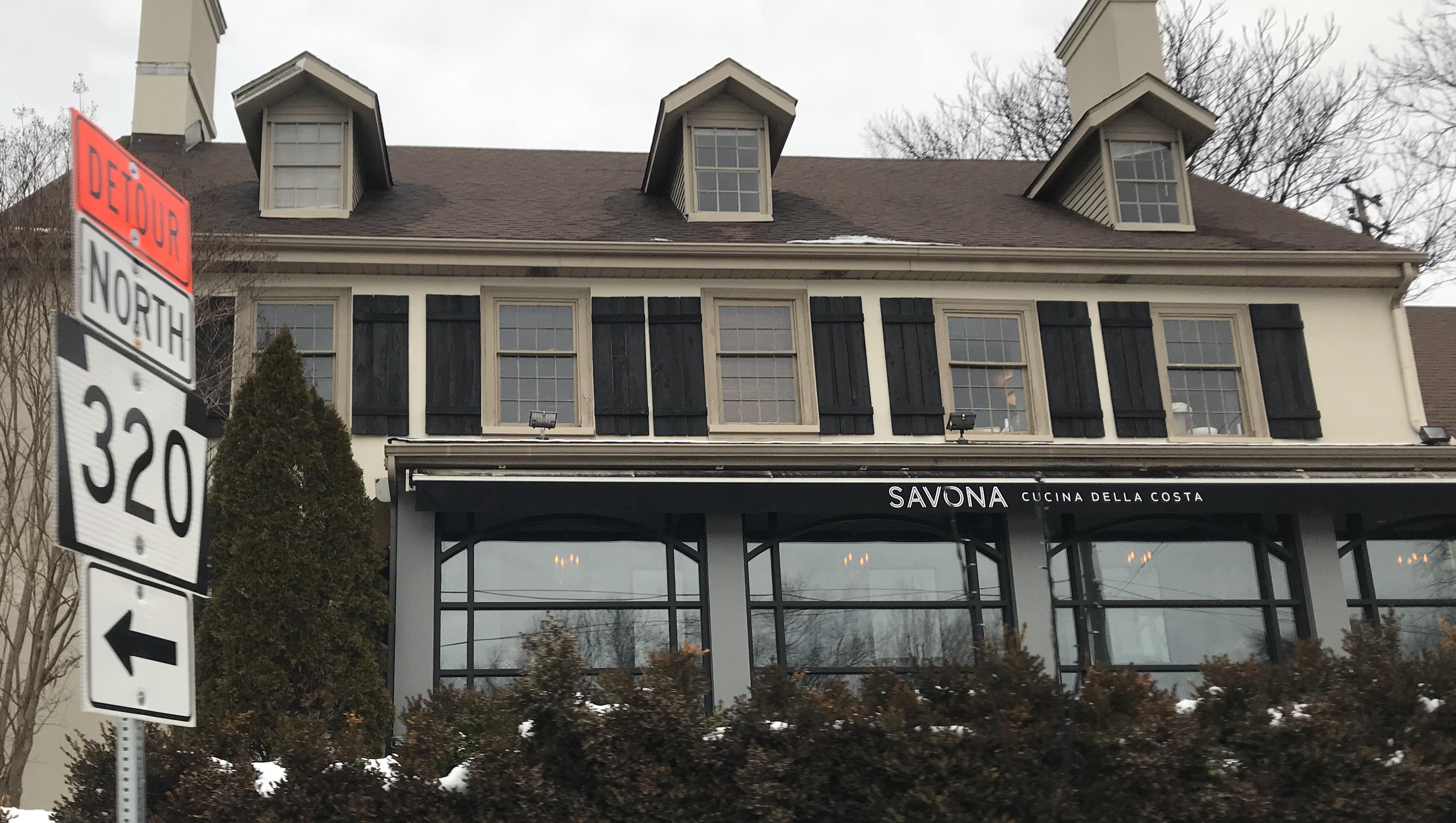
Look for an upcoming email to find out how you can write for The Index!
campus opinions
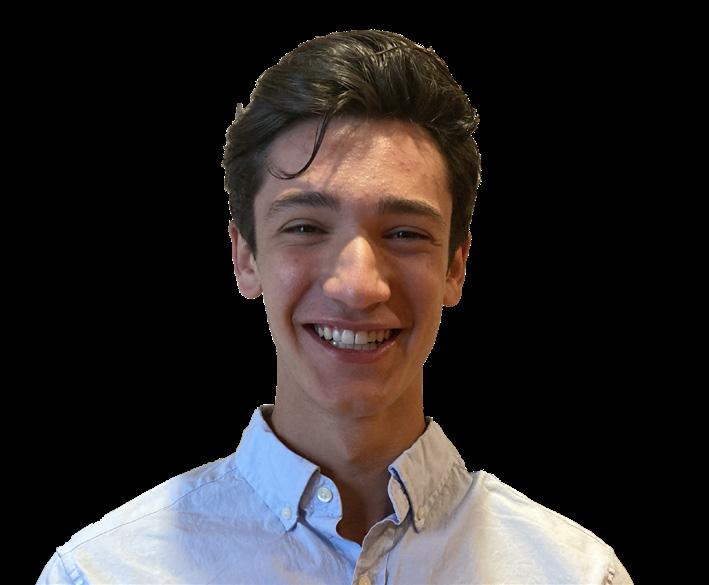
Grade-wide detention only unifies Sixth Form skippers
Tyler Zimmer ‘21
Ienjoyed detention. I respected Dean of Students Mr. Luqman Kolade, and he respected me. I spent it writing, and he graded writing. He welcomed us into the Big Room and checked us off as if it was my fourth class of the day.
“No games,” Mr. Kolade told the group of Sixth Formers.
But we didn’t need games. We had each other. One student turned his head to see if Mr. Kolade was watching him. He was. They had this exchange of thoughts without uttering a word.
I’m sure he was thinking, “Is he looking? Yes, he’s looking. Okay, fine. I’ll open a Google doc.” And so he did.
The mood took a turn about ten minutes in. Spacebar clinks and divergent footsteps replaced smirks and giggles. As a howling wind crept through the top right window pane—a student must have left it unlatched in the fall—the sound transformed. I closed my eyes and listened. The sound would emerge and vanish, but after a few waves, I snapped back to reality. I could only focus on this noise because, simply put, it was the only noise. Everyone was so quiet.
I enjoyed my three-by-four, imaginary glass house that surrounded my desk. I was on trial for my crime, and I could not post bail, so I had to wait. And wait I did.
Haverford has never allowed me to do nothing, let alone forced me to. If I ever dozed off in class, I receive a figurative splash of water in my face—“Tyler, tell me what I just said about ultraviolet radiation.” Of course, I had no idea. But detention was no
class.
For me, it was a gift—more like a demand—to do nothing, and it forced me to be more attentive than I ever have. Who knew there is an exposed steel rafter? Why is the Big Room so illuminated? Out of twenty of my peers, who would have thought that almost all of them were getting ahead on their work?
My brain wandered from insignificant details to the reason I was sitting there: group punishment. The purpose of this detention was to ensure that sixty or more of my peers attend school. The more I thought about it, the more I realized how low the bar was. And yet, this punishment was counterproductive.
Every five minutes or so, I’d hear a muffled laugh from a student who, like me, was enjoying his detention, but didn’t want Mr. Kolade to find out. My peers would lock eyes, smirk, then turn away. This continued to happen intermittently.
When my computer read “3:30,” and we were free, there was no sense of urgency.
“You’re good,” Mr. Kolade announced, but students finished their paragraphs or problems before getting up. A handful of them remained seated and shared a laugh.
It seemed as though everybody in the Big Room benefitted from detention. I made a few observations, my peers were more focused than I’d ever seen them, and Mr. Kolade had the chance to relax, as nobody made his supervising role overly difficult.
Although I felt trapped in my small glasshouse for the hour, I did not feel alone. The twenty of us—the same can be said for the other rooms—were unified.
If I am not alone in my opinion that Wednesday, February 10 from 2:30 to 3:30 was a pleasant and productive experience. I believe there was no punishment at
all.

Quinn Luong ‘22
Dear Homophobic Peers, I am tired of your blatant homophobia targeted to students like me and the Diversity Alliance. Over the course of the past weeks, I have now heard from several people who have told me what students at Haverford assume about Diversity Alliance and our logo: “Why do you have a rainbow as your logo? Diversity Alliance is full of gay people. I am not joining that gay club.”
I was deeply saddened. I had this familiar lump stuck in my throat because it was difficult to process these homophobic comments. My sadness turned into exasperation. I was angered by the sheer audacity of my peers to gaslight our work in the Diversity Alliance. But I was not surprised because homophobia is not something new for this community. Incidents like these have been happening for a long time.
Homophobia is a problem at Haverford.
This is not about some misconstrued assumption about our logo with a rainbow on it. There is more than what meets the eye: institutionalized homophobia.
The cycle of homophobia starts from little comments that seem “harmless.”
That is so gay; you look so gay; stop being so gay, for example.
These comments contribute to a toxic institutionalized homophobic culture. Peers have used these phrases to target students like me in this community who are different, exiling and humiliating them in front of their classmates. I have heard these comments ever since I came here in sixth grade.
Dear homophobic peers
I still hear them today. I am aware of people who were forced to leave this community in fear of trauma and abuse.
I remember begging my parents to leave at one point. Trust me, it has been ugly.
The recent history of institutionalized homophobia at Haverford dates back to 2004. A Black student approached the administration with the idea of creating a GayStraight Alliance (GSA), but it was struck down by the school board. Having a GSA was perceived as “too radical” by students and administration. It would take fourteen years for the first GSA to come about during my Third-Form year. This stigma has lasting ramifications.
When the GSA was created just three years ago, few people joined because there was a toxic stigma associated with it. It still holds true today. You could not just be an ally in GSA because anyone who joined was seen as “gay” and immediately ostracized. I remember putting up GSA meeting posters all around the school. One day, I was walking down the stairwell after class among a crowd of students. Hurrying past a sea of bodies, I passed by one of the posters, and in the corner of my eye, I saw the “f–” slur visibly and unmistakably written on the poster. I remember standing there, shocked, scared for my life. Everyone walked past me, unnoticed and unbothered.
I didn’t feel safe after that day. The vandalism is gone, but the student is not.
I’ve experienced homophobia ever since I came to Haverford. After so many years, I am used to it. I should not be.
I have worked so hard to build a safe and accepting space so that nobody would have to go through the torture and constant harassment I endured. Every time I lead a Chit-Chat & Chew, send a school-wide email, or write an article in the newspaper, I am conscious of the attention that is drawn to me and the nasty things that I have been called. My peers have called me slurs behind my back, and now, they are targeting the Diversity Alliance with hateful and homophobic rhetoric.
When it felt like the entire school hated me, I at least had a safe space to talk about it. The Diversity Alliance was that space. My peers attack and push back the Diversity Alliance in any possible way. It is either that we are too gay, too liberal, too boring, or that we are doing something wrong. I am tired of it. I have put my blood, sweat, and tears into making Haverford a more just and equitable space, and I am constantly scrutinized for my progressive actions.
The Diversity Alliance Executive Team met various times, trying to change the logo because of the criticism we received. We thought the rainbow in the logo was the problem and people did not want to be associated with it. But we finally realized our community is the problem. Our peers were not just attacking our logo, but the Diversity Alliance altogether.
Every day, I try to believe that Haverford is getting better. But every single time I do, I am reminded that it is not.
My greatest fear is that all the work I have dedicated to Haverford will amount to nothing. I am terrified for the future generations of students who will have to bear similar traumas.
I am not asking for your sympathy; I am calling for change. We must dismantle toxic masculinity within our community. We need to recognize that homophobia is a problem at Haverford, and unless we address it, nothing will change, and we all will be complicit.

the index · off-campus opinions
off-campus opinions
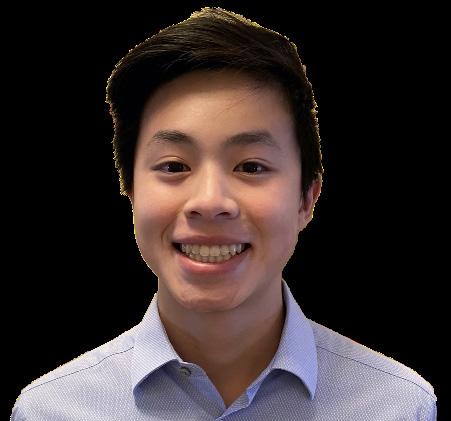
Wall Street adjusts to a post-GameStop world
Ethan Chan ‘23
Wallstreetbets. Amateur daytraders. Reddit. Melvin Capital. Elon Musk. “To the moon.”
These are just some of the familiar names, companies, and phrases involved in the meteoric rise and fall of common stocks such as GameStop and AMC. Both stocks had risen over 500% respectively in a matter of days and caused over $400 million in losses for hedge funds such as Melvin Capital. Despite their near overnight success, what exactly fueled this phenomena?
Earlier this year, a group of individual investors through a group better known as WallStreetBets planned to put a squeeze on several hedge funds on Wall Street. Hedge funds such as Melvin Capital bet on the fall of GameStop shares and WallStreetBets acted accordingly.
Logically, this seemed impossible to pull off. These amatuer investors were going against analysts whose jobs revolved around the well-being of the stock market. Afterall, GameStop wasn’t a company that attracted investors. It was the type of store one would find on a strip mall. To exacerbate the poor returns of GameStop, it had been heavily affected by the pandemic. This was a dying company and only a miracle could save it from bankruptcy.
The collective effort from these individual investors, small brokers, and others buying shares, this caused GameStop’s market value to sky rocket over $22 billion in less than a week. The seemingly crazy increase in GameStop’s stock value caused an uproar in the business world, namely the younger generation with Wallstreetbets. In the eyes of many young GameStop investors, they
had leverage over these hedge funds and outsmarted them.
Elon Musk was seen as the dark horse in the GameStop scenario. His often sporadic tweets have resulted in the sudden rise and fall of Tesla shares. By promptly stating “Gamestonks” on Twitter, the gaming company saw a substantial increase in stock price. At the time, there was no definite limit to GameStop and other common stocks that would follow suit, thus emerged the term “to the moon.” GameStop was very well on the course to the moon until Robinhood, a popular trading platform, stopped all trade for it and similar stocks.
On the morning of January 28, Robinhood stated that it would prevent users from buying stocks such as GameStop in light of market volatility. In response, day traders and those involved went into a frenzy on the internet. Significant figures that advocated for the rights of the traders involved were not limited to Barstool Sports’ Dave Portnoy, Representative Alexandria Ocasio-Cortez, and Senator Ted Cruz. On Fox News, Portnoy firmly stated, “Somebody has to go to jail for this. This was intentional market manipulation.”
Although no one knows who will be going to jail, CEO’s of Reddit, Robinhood, Melvin Capital, and Citadel Securities will testify before the U.S. House Financial Services Committee on February 18. After the events that occurred regarding Robinhood, several stocks including GameStop saw high levels of short interest consequently dropping the stock prices significantly. One can only think of former stockbroker Jordan Belfort, the infamous main character in the 2013 film Wolf of Wall Street. Making his short-lived fortune off of “pumping and dumping” penny stocks, Belfort found success but was ultimately indicted for security fraud and money laundering. Although many stockholders of GameStop and AMC won’t share the same fate, there was a threshold that Belfort breached due to his greed that caused his downfall. The urge to keep on holding for many of these traders was a notion of greed and the unpredictability of these stocks.
From these events, many lessons can be taken away. The rise of GameStop and other similar stocks were the byproduct of the united power of the people and the internet. Those who have a monopoly over the economy and market can dictate to their interests.
Going forward, the market is still unprecedented in its next step. Will there be a next GameStop? All we can do is see what will happen and “hold.”


(NASA/BILL INGALLS) WIKIMEDIA COMMONS
Elon Musk, SpaceX Chief Engineer participates in a SpaceX Demonstration Mission 2 Launch Briefing on Wednesday, May 27, 2020

arts
Notables in the COVID era
Ethan Lee ‘24
One of the school’s distinctive groups, the Notables, stands among the many groups that have had to reformat operations in the COVID-19 pandemic. Still, the a capella group is working hard to continue increasing their repertoire.
To practice safely, no more than fourto-five boys are in Mr. Hightower’s room at once for rehearsal. The only times the group has actually “met up” is over Zoom.
“We are doing four or five groups of boys in Mr. Hightower’s room at once because that is all we can do now,” Sixth Former Ben Fosnocht said. “We work in our voice parts as in a mixed group with one person from each voice part.”
Additionally, Mr. Hightower created packages containing a microphone, microphone holder, and an audio interface for each person. There are microphone stands set up around the room where each singer puts their microphone on, all linking to Mr. Hightower’s computer in the middle of the room.
“We are all spaced out so that we can be safe,” Third Former Render Ford said. “We use the microphones to hear each other instead of being near each other.”
Members of the Notables also use the microphones at home to record songs.
“The microphones allow us to have almost the same audio quality,” Fosnocht said. “It is good to have the technology that allows us to sound like we are still singing in
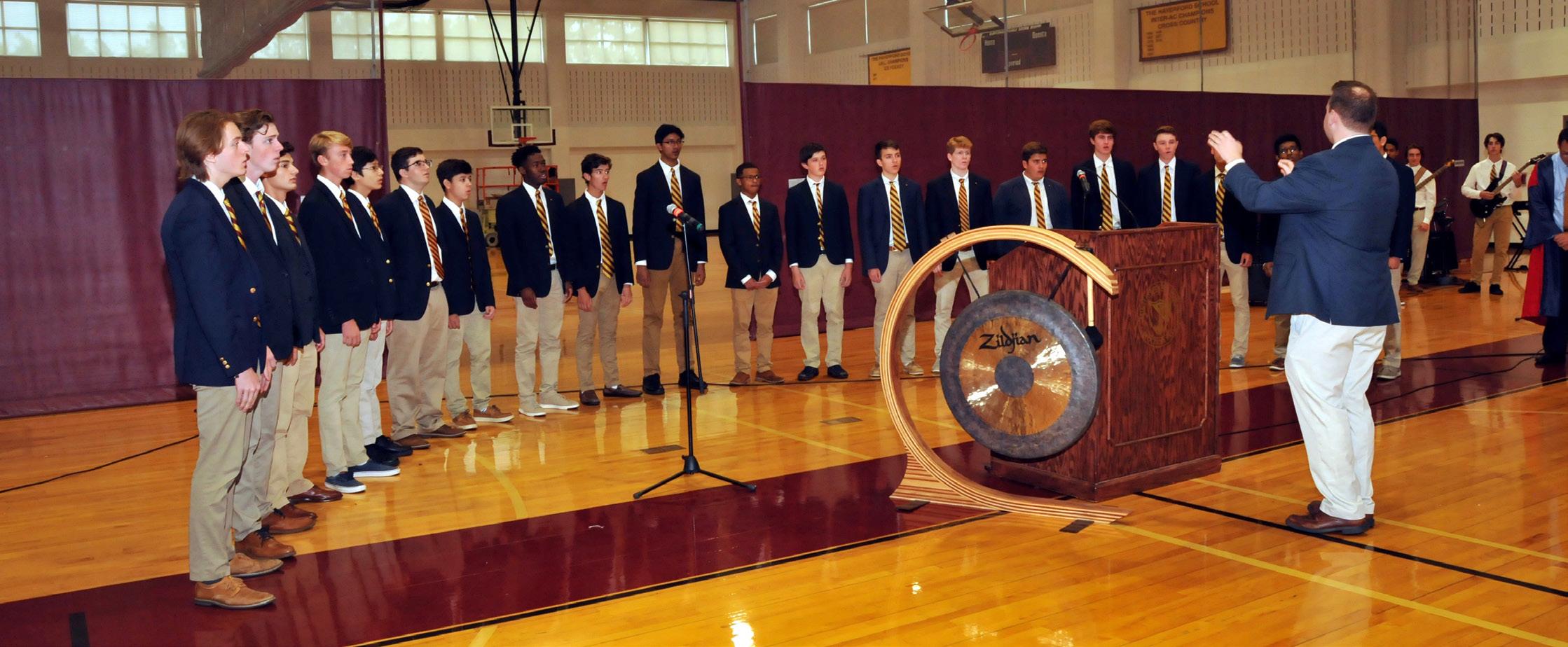
COMMUNICATIONS
The Notables in pre-COVID times, opening day, 2019 person.” Virtual students are still able to participate in the rehearsals.
“[Mr. Hightower] has a Zoom projected on the board so that I can still participate in rehearsals even though I am virtual,” Fourth Former Harvey Penington said.
Even though they practice in-person, about half of the group’s rehearsals are entirely online.
“Every week we are in a different format,” Fosnocht said. “Any time we can rehearse in-person in sectionals or online over Zoom.”
Unfortunately, The Notables have not been able to perform at all so far this year. Normally, they would have 40-50 performances around different venues in a year, but they have only “performed” once this year in the virtual Winter Concert. But, the Notables plan to perform for graduation later this year. “A big part of being in the Notables is being able to perform,” Fosnocht said, “This year is just different.” Additionally, The Notables are working with Glee Club and Haverford’s sister schools to sing a rendition of “Non-Stop” from Hamilton. “I am really looking forward to both of these projects,” Fosnocht said. “I think they will turn out great.” Before these performances, the Notables released music for their cover of “Winter Wonderland.” Filmed and edited by Third Former Pierce Laveran, the video was used as a way to publicize their Toys for Tots concert.
“Since we don’t have any concerts this year, this video was a way to show people what we are doing,” Pennington said. “We only had a short amount of time to film, and I think Pierce did a great job efficiently shooting the entire video.”
Even with all of these restrictions, members of The Notables are still happy with the work they are doing.
“The whole group is committed to taking what we can get,” Fosnocht stated, “And making the time we have together as special as it always is.”
Architecture with a twist
Jake Maddaloni ‘21
With awkward twists and turns, spectators might have to look twice at the “Dancing House” because, at first glance, the building looks like something from another world.
Looking over land that was once the site of a bomb attack, the Dancing House’s contorted architecture cannot be compared to any other building in the Czech Republic, or the world, for that matter. Constructed in 1996, the Dancing House stands to memorialize the famous dancers, Fred Astaire and Ginger Rogers. The twists and peculiar features of the building symbolize the two legendary performers dancing.
Initially, there was controversy surrounding the ethics behind the oddly shaped building because the general public believed it would take the attention away from the more traditional works of art located near the Dancing House. During the Dancing House’s origins, the public petitioned to stop the construction because it seemed out of place in a classic city like Prague. Still, the movement to assemble the building continued because famous architect Frank Gehry led and supported the cause. Gehry believed that post-modern architecture needed to be unique and different from conventional buildings.
“People ask me if I am an artist or architect, but I think they are the same,” Gehry said.
The Dancing House is a complex twopart building, the left side of the tower represents Ginger Rogers and the right side represents Fred Astaire. The building’s left side displays twisted glass, which portrays Rogers dancing. One-third from the bottom of the building, a spectator can see the glass shoot out sideways with inclined columns jetting out from underneath. The glass flattening out represents Rogers’ skirt, and the columns serve to illustrate her legs.
Alongside the contorted glass structure stands the second part of the Dancing House. Constructed purely with concrete, the right side of the building represents Fred Astaire. The most distinct feature of this part of the building is the top of the tower, which has concrete scraps sculpted to appear as Astaire’s hair. His side of the building has incredibly unique window architecture. The windows are non-linear to the ground, meaning the windows stick out towards the street. The feature of non-linear windows broke a barrier in post-modern art because instead of making something appear three-dimensional, art can genuinely be built three-dimensional.
The Dancing House symbolizes more than one may think at first glance, which is why it is considered an authentic piece of post-modern art. The two dancers’ legacies continue into our time with the Dancing House.
Despite the controversy that initially surrounded the Dancing House, it is now widely regarded as an architectural gem of
FRANK GEHRY
Prague. Home to a restaurant with a 360-degree view of Prague, the Dancing House offers world-class views within its unique deconstructivist-style building. Architects like Frank Gehry allowed the world of architecture to include structures that differ from the standard design. Still, many artists frown upon the idea of deconstructivism because some believe post-modern art is an eyesore.
“Most of our cities built since the war are bland. They’re modernist, they’re cold, and now architects want to go back to that,” Gehry said.
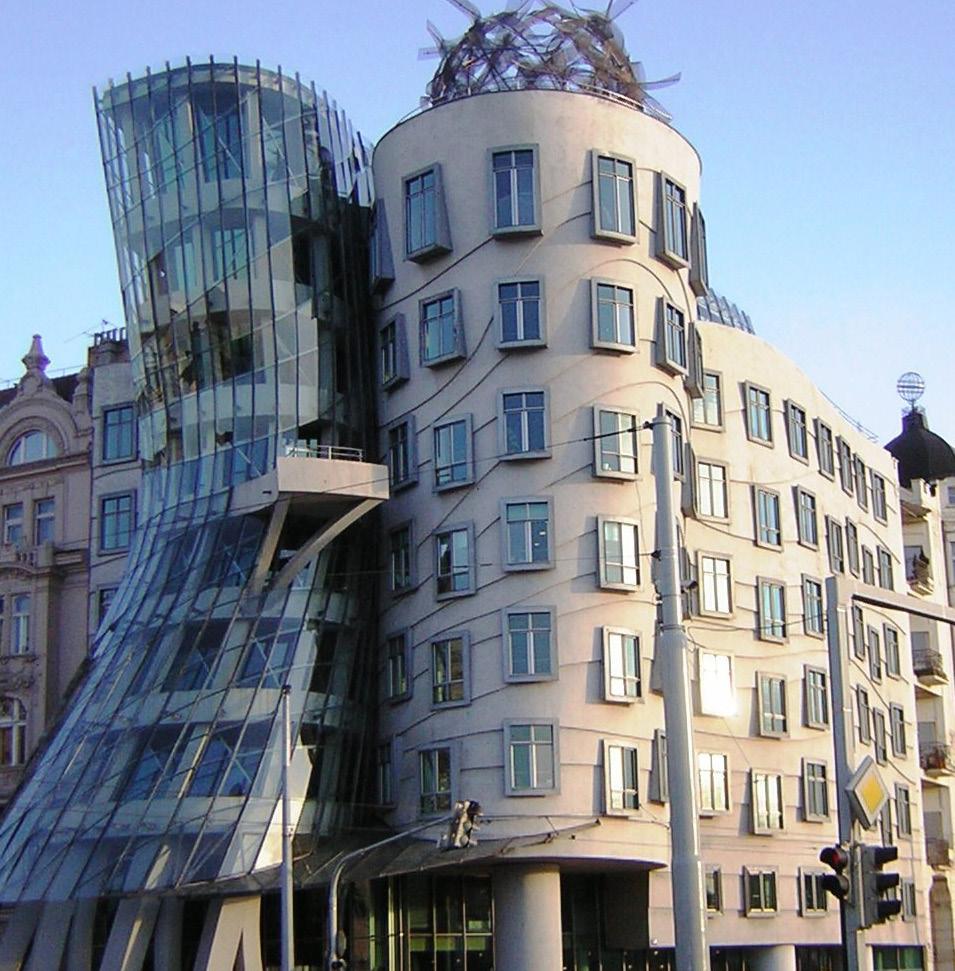
February 2021 Reflection of imperfection: Lucian Freud redefines the self-portrait Tyler Zimmer ’21
Mr. Parker’s crossed legs and unblemished skin. Mr. Dixon’s luscious hair and relaxed shoulders. Dr. Cox’s content grin and professional poise. Down the hall from our beloved sweater hang eight flattering portraits of Haverford’s heads of school preceding Dr. Nagl. They highlight each man’s character and passion through facial expressions and still-life objects. Each portrait casts the man in his best light.
Portrait savant Lucian Freud took a completely different route in 1985—and his entire career—with his piece, Reflection (Self-Portrait). Characterized by harsh color contrasts and attention to unattractive detail, Freud redefines the typical portrait, favoring reality over illusion. “The painter must give a completely free rein to any feeling or sensations he may have and reject nothing to which he is naturally drawn,” Freud wrote in his autobiography. While many painters’ backgrounds influenced their work, Freud’s past defined his work. Grandson of Sigmund Freud—neurologist and creator of psychoanalysis—the need for a complete understanding of human emotion ran in the family. Oftentimes, Sigmund would leave Vienna, Austria, to visit Lucian’s family in Berlin. He gifted the young Lucian books, comic strips, and most importantly, paintings. Very quickly, Lucian Freud became an avid painter. “It is the only point of getting up every morning: to paint, to make something good, to make something even better than before, not to give up, to compete, to be ambitious,” he said. But Freud did not take a conventional approach to painting. He became obsessed with the human body and portraits. Instead of focusing on the beauty of the human body, he brought out the truth. Benefits Supervisor Sleeping, his most profitable piece valued at $33.6 million, depicted a woman paying special attention to her burdened face and ample body. In order to fully understand Lucian Freud’s most famous portrait, his own selfportrait, you must think of him as more than a painter. His grandfather Sigmund studied the mind, and Lucian took Sigmund’s work one step further; Lucian Freud speaks about the same inner workings of the mind, just with a different medium: painting. Regarding his strategy on displaying real human emotion, he said, “The longer you look at an object, the more abstract it becomes, and, ironically, the more real.” Up close, Reflection is made of large brush strokes. One would think large brush strokes take away Freud’s ability to capture small details, but this is not the case; it is purposeful. Freud uses large marks to create hard edges, ultimately casting a face that appears to have aged poorly. Rather than fading colors into a gradient, he uses chunky, blocked strokes that make his wrinkles more prominent. An escapee of Hitler’s Nazi regime, it is no surprise that Freud’s face reflects a difficult life. It follows the same pattern as his previous work, focusing on the hard truth. Nearing the end of his painting career Freud said, “Now the very least I can do is to paint myself naked.” Naked can be interpreted in one of two ways: nude, or revealing. While many of his portraits use the former—he said, “When I’m painting people in clothes I’m always thinking very much of naked people”— Freud uses the latter in Reflection. He reveals himself through the color palette. Since the background is a cool, dull brown, Freud’s aging upper body appears directly in contrast. But just beneath his face is a shadow, not coincidentally the same color as the background. His olive skin tone darks contrast the yellow tinted brights, creating shadows within individual skin folds and furthering the wrinkle and old age premise. A handful of factors play into the title Reflection. Because of the contrast between contoured face and monochrome background, Freud appears closer to the viewer, hinting at the out-of-body experience we all have when lost in thought. His eyes, notably disproportionate and asymmetrical, exist in non-parallel gazes, displaying both Freud’s imperfection as a man, but also his moment of self-reflection that the title insinuates. A portrait can be flattering, or it can be real; no man is as perfect as their pose. Freud never paints from a picture, and even allows his subject to move around; he painted his self-portrait in the mirror. Where many tell satisfactory and simple stories through their portraits and self-portraits, Lucian Freud aims to unsettle—he tells the truth. “It’s purely autobiographical,” he said.
LUCIAN FREUD

COURTESY OF GANDALF’S GALLERY LICENSED WITH CC BY-NC-SA 2.0 Lucian Freud’s Reflection (Self-Portrait)
WandaVision challenges non-Marvel fans
Connor Pinsk ’23
Despite a severe lack of advertising, Disney+ has released their newest TV series, WandaVision. The show is named after its two main characters Wanda Maximov (Scarlet Witch) and Vision. WandaVision, like many other Disney+ shows, is releasing one new episode per week, but, unlike The Mandalorian, this schedule may not be enough to retain their viewers.
The first episodes of the show did anything but make me want to watch the next one because I was so confused. Almost every episode of the show takes place in a different decade, with the first set in the 50s and the most recent episode taking place in the early 2000s.
The show’s setting is a small town where everyone is in a trance, and the people in the trance are actors along with Wanda and Vision. Meanwhile, as everyone in the trance is acting in a show, the show itself is broadcast to the outside world. Eventually a government agency under the name of S.W.O.R.D. goes to investigate this phenomenon and discovers more of the broadcast.
One of the major problems with this series is that there are many references to the past Marvel movies. If someone who had never seen a Marvel film began watching this show, they would be lost, and I cannot imagine that they would enjoy it.
For Marvel fans, the show does improve as the puzzle pieces click together.
WandaVision is just the first release of many Marvel television series that Disney+ has in the works, with Falcon and the Winter Soldier—a show that will most certainly trigger more excitement—debuting on March 19.

sports
Armed with a new coach, squash aims to maintan dominance
Joey Kauffman ’23
Mr. Alex Stait, the new squash coach, has operated at the upper level of his sport for quite some time. Born in England, Mr. Stait played professionally in the World Tour before he retired and started coaching. He coached at Agnes Irwin for seven years before Haverford, where he watched the team go from 31st in the country to second.
Mr. Stait also coaches the US men’s junior team in the world championships each year, an event in which he was able to

ETHAN LEE ‘24
Quintin Campbell ’21 in a match against Penn Charter on February 12, 2021 coach many of Haverford squash players. As Mr. Stait adjusts to Haverford, he hopes to continue the team’s success while fostering a strong sense of unity.
“[Haverford] is one of the best teams in the country, which is a great thing, but also brings out other issues at times,” Mr. Stait said. “My role is really to make sure that [the competitiveness] doesn’t go over the top and to make sure that we’re all fighting together.”
Indeed, the team has not only benefited from the extensive experience that Mr. Stait brings, but also from his leadership and team-building capabilities. His push for the team to “fight together” has transformed the culture from previous years.
“Before, the team wasn’t that close together, but now, since Alex [Stait] and Coach Walters have come, we’ve really been able to become stronger as a team,” Sixth Form captain Matthew Wang said.
The team’s recent match against EA, which they won 9-0, is one example of the benefits of the team environment.
Wang said, “There were some tight matches [against EA], but that support that we’ve garnered together really pushes us to be an excellent team.”
Still, team bonding alone does not win matches. Coach Stait wants the players to be at the top of their game, and one way he does this is by making sure they are physically the best they can be.
“In my opinion, there’s no excuse for not being fit. You might not be as good as your opponent—they might be better than you—but fitness and that sort of thing is just about hard work, and we won’t be losing matches because we haven’t worked hard enough,” Stait said.
Team members have embraced the drills and focus on fitness.
“I feel like [the drills and fitness] are really helping my game in general,” Fourth Form squash player Owen Yu said. “I feel like I’ve just been improving a lot more since school squash started.”
In addition to coaching the upper school team, one of Mr. Stait’s more longterm goals is to make squash a more accessible sport. He described how, in England, squash is an inexpensive sport, with “a lot of different social demographics playing.” He said that it “couldn’t be any more different from here.”
One reason for Haverford squash’s dominance is simply that we have access to squash courts and coaches while most schools around the country don’t. With US Squash, Mr. Stait is working to change that; one specific goal in the future is for the school team to partner with SquashSmarts, a free squash club in Philadelphia for public school students.
At Agnis Irwin, Mr. Stait was able to coach three girls who had never joined a private squash club and turn them into varsity players. He wishes to do the same here and hopes that students “who aren’t members of private clubs will be able to come here and play.”
Swimmers adapt to new training
Jake LaRocca ’22
Following Winter Break, the swim team dove back into the pool for the first time since February 2020. The short season poses many challenges to the swimmers. A majority of the season is typically spent training, and the last month or so is dedicated to racing. This year, the team had its first meet on February 4, just one month after the start of practices.
“The training we do as a team is usually broken up into three phases. Conditioning phase, power phase, and a taper phase,” Coach Sean Hansen said. “The first conditioning phase is four-to-five weeks long that focuses on the details of swimming: turns, stroke technique, underwater kickouts, and some aerobic conditioning to get into swimming shape. The second power phase is primarily the heaviest training of the year which takes place through winter break until we start our dual meet season in January. This consists of some anaerobic training, Aerobic Threshold training, and speed work. The final phase is our taper phase. The ‘taper’ concept is one in which you start to gradually decrease the amount of speed and power training while increasing your recovery time heading into a peak competition.”
Instead, the team adopted a training style known as USRPT. The style shortens

COMMUNICATIONS
Jack Deppen ‘21 at a swim meet on December 10, 2019 the lengths of practices but increases the intensity.
“USRPT challenges our traditional training methodology of swimming slower all the time in hopes of building a big foundation and peaking after a rest or taper period. Instead, with USRPT, the goal is to swim fast all the time. If you want to swim fast, you have to train your body to perform fast. This training is combined with a complex dryland/lifting regimen that consists of both endurance and power lifts, all coupled with ample recovery time,” Coach Hansen said. For practically all of the team, the training style is unique. However, the team seems to like the short, intense training. “I’m a huge fan of the training,” Sixth Former Koenig said. “As I am still recovering from a serious shoulder injury that had me sidelined for all of last season, I benefit from the training because I had to teach my body how to race again. The training has also given me an opportunity to ease back into it, as the lengths of practices are practically cut in half.” Despite the short season and other short-term obstacles, the Fords are still amped up to finish out the season.
Sixth Former Jack Deppen is confident with how the team has done despite all the obstacles.
“It seems like every single week there is something that gets in the way of our practices. Since we can’t practice on weekends or days off, we definitely have limited time in the pool,” Deppen said. “We’re definitely bringing the intensity to practices in the pool as well as in the weight room. I’m proud of everyone’s hard work and am confident we can finish our season strong.”


